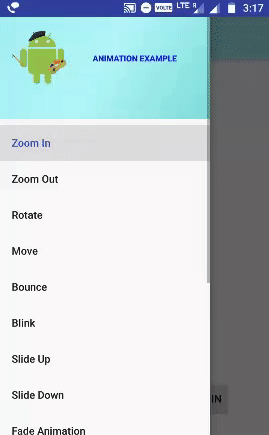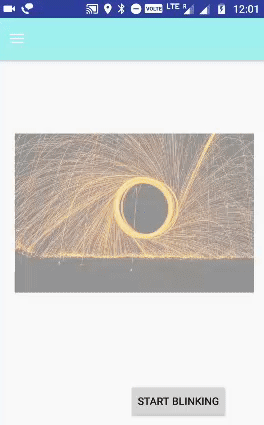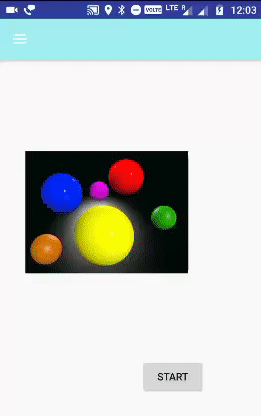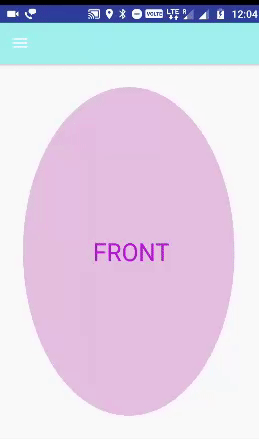How To Slow Down Translate Animation Android
Animation Tutorial With Example In Android Studio
Property Animation API was introduced past Google in Android 3.0 which gives us the flexibility to change object backdrop over a sure time interval. The Animations Framework allows us to create visually bonny animations and transitions in our apps. Using the animations, one can plough their good looking app into an fantabulous and highly usable app.
 Animations are useful when the screen changes state, i.due east when the content loads or new actions go available.
Animations are useful when the screen changes state, i.due east when the content loads or new actions go available.
Animation is the process of creating motion and shape change. In this Tutorial we will show how simple animations encourage you to employ them more freely and confidently.
Animations notify users about what's going on in your app and improve the mental model of your app'southward interface.
Android Defines 3 Types Of Animations:
View Animation:
This is the simplest blitheness used in Android. It ascertain the properties of our Views that should be animated using a technique called Tween Animation.Information technology take the following parameters i.e. size, time duration , rotation angle, start value , end value, and perform the required animation on that object.Y'all can execute the animation by specifying transformations on your View. This can be done in XML resource files or programmatically.
Android View animation can make animation on any View objects, such equally ImageView, TextView or Button objects. View animation tin can only animate uncomplicated properties like position, size, rotation, and the alpha belongings that allows you animate the transparency of a View.
The drawback of this mechanism is that it can merely be applied to Views.
Belongings Animation:
This animation was introduced in Android 3.0 (API level 11). It allows the user to animate annihilation.
Belongings animations are highly customizable, yous can specify the duration, the number of repeats, the blazon of interpolation, and the frame charge per unit of the blitheness. The Belongings Animation system is always preferred for more complex animations.
Property animations allow us to animate whatever belongings of any object from one value to another over a specified elapsing. Permit us take an case, imagine yous wanted to breathing the 3d rotation using the rotationX or rotationY properties that were introduced in API eleven. Or possibly you desire to animate a color change or breathing the change of a drawable. This is not possible by using View Animations. For this purpose Holding Animation is used .
Y'all are not limited by predefined animation types or by the type of object that you want to breathing. At first the usage of the Property Animation System might seem a petty complicated. However, in most cases you tin can use the very versatile ObjectAnimator that uses reflection. The ObjectAnimator makes creating Property Animations almost as easy as creating View Animations.
Common properties ordinarily animated on views include:
| Holding | Description |
|---|---|
| blastoff | Fade in or out |
| rotation, rotationX, rotationY | Spin or flip |
| scaleX ,scaleY | Abound or shrink |
| x,y,z | Position |
| translationX, translationY, translationZ (API 21+) | Showtime from Position |
Drawable Animation:
This blitheness allows the user to load drawable resources and display them ane frame afterward some other. This method of blitheness is useful when user wants to animate things that are easier to stand for with Drawable resources.
To use Animations in Android , Android has provided us a class chosen Animation.
To perform animation in android , we volition call a static function loadAnimation()(this method is used to load animation) of the class AnimationUtils. We are going to receive the outcome in an example of Blitheness Object. Its syntax is every bit follows −
Animation animation =AnimationUtils.loadAnimation(getApplicationContext(), R.anim.myanimation);
Second parameter refers to our animation.xml file.It is created under res directory(res->anim->myanimation.xml)
The Animation form has many methods given below:
1.showtime():This method will start the blitheness.
2.setDuration(long duration):This method sets the duration of an animation.
iii.getDuration(): This method gets the elapsing.
4.terminate(): This method ends the animation.
5.cancel(): This method cancels the animation.
Setting The Animation Listeners (Optional)
Animation listeners tin be set past implementing AnimationListener in our Activity. If you will use AnimationListener, and so you volition accept to override following methods.
onAnimationStart –
@Override public void onAnimationStart(Blitheness animation) { } onAnimationEnd–
@Override public void onAnimationEnd(Animation animation) { } onAnimationRepeat–
@Override public void onAnimationRepeat(Animation animation) { } Scale Animation
Scale Blitheness is used to make a smaller or larger view either on x axis or y axis. Pivot betoken can also be specified around which we want the blitheness to have place.
Rotate Blitheness
Rotate Animation is used to rotate a view effectually a pin betoken by a certain number of degrees.
Translate Blitheness
Interpret Blitheness is used to motion a view along the x or y axis.
Alpha Animation
Transparency of a view can exist changed by Alpha Animation
Interpolator:
The dictionary pregnant of Interpolate is to modify, intercept or insert in between 2 things or events.
Information technology is used to insert or apply an additional blitheness effects between the get-go and the end value of the property of an object.It is as well used to define the rate of modify of an animation.
Types of Interpolator:
i.Linear Interpolator:It is the default interpolator of all animations. It defines that the rate of the change of the animation is constant.
2.Accelerate Interpolator: Accelerates the moving of the view, information technology starts out slowly and and then accelerates until it reaches the final position.
three.Decelerate Interpolator: Does the opposite of the accelerate interpolator. It starts out fast and the slows down.
4.Accelerate Decelerate Interpolator: Makes the moving go slow at the starting time and the cease, but fast in the middle.
5.Conceptualize Interpolator: Moves the animation backwards before information technology starts
6.Overshoot Interpolator: Does the opposite of the anticipate interpolator. It brand the animation to become further than the defined destintion, and then get back to the defined destination.
vii.Anticipate Overshoot Interpolator: Combines the conceptualize and the overshoot interpoplator. The change starts backward then flings forward and overshoots the target value and finally goes back to the final value.
8.Bounce Interpolator: Makes an bounce animation before the desired blitheness ends.
9.Cycle Interpolator:Repeats the animation for a specified number of cycles.
Important XML Animation Attributes In Android:
one. android:duration: The duration in which animation is completed is referred to as elapsing aspect. It refers to the ideal duration to show the transition on the screen.
android:duration="1500"
two. android:fillAfter: This aspect defines whether the view should be visible or non at the end of the animation.We take set its value true in our animation. If it would set to simulated then element changes comes to its previous country after the animation.
android:fillAfter="true"
three. android:interpolator: This property refers to the rate of change in blitheness. You can define your ain interpolators using the time as the constraint. In this animation we have used an inbuilt interpolator i.e. linear interpolator.
android:interpolator="@android:anim/linear_interpolator"
4. android:startOffset:Information technology refers to the waiting time before an blitheness starts.
android:startOffset="2000"
5. android:repeatMode:When user wants the blitheness to be repeated and so this attribute is used
android:repeatMode="restart"
6. android:repeatCount: This attribute defines the number of repetitions on animation.
android:repeatCount="space"
Animation Example In Android Studio Showing fourteen Types Of Animation:
Below nosotros will create i consummate animation example in Android Studio which volition brandish 14 different types of Blitheness. Nosotros will put the fourteen types of Animation names in NavigationDrawer menu and onclick of names in menu that particular Animation will work.
Beneath yous can download code, see final output and footstep by footstep explanation of example.
Download Code

Step 1: Create a blank new project and name it AnimationExample
Step 2: Select Navigation Drawer Activity from Create New Projection dialog, click next and so finish.

Important Note: When you select Navigation Drawer Activity for your project it will create four xml files inres =>layoutfolder and thecontent_main.xml file amidst four is important which we will use in our projection.
Step 3: Setting up NavigationDrawer for our example to show dissimilar types of Animations list in Navigation carte du jour.
activity_main.xml code:
<?xml version="1.0" encoding="utf-8"?> <android.support.v4.widget.DrawerLayout xmlns:android="http://schemas.android.com/apk/res/android" xmlns:app="http://schemas.android.com/apk/res-auto" xmlns:tools="http://schemas.android.com/tools" android:id="@+id/drawer_layout" android:layout_width="match_parent" android:layout_height="match_parent" android:fitsSystemWindows="true" tools:openDrawer="start"> <include layout="@layout/app_bar_main" android:layout_width="match_parent" android:layout_height="match_parent" /> <android.support.pattern.widget.NavigationView android:id="@+id/nav_view" android:layout_width="wrap_content" android:layout_height="match_parent" android:layout_gravity="showtime" android:fitsSystemWindows="truthful" app:headerLayout="@layout/nav_header_main" app:menu="@menu/activity_main_drawer" /> </android.support.v4.widget.DrawerLayout>
app_bar_main.xml code
<?xml version="1.0" encoding="utf-8"?> <android.support.design.widget.CoordinatorLayout xmlns:android="http://schemas.android.com/apk/res/android" xmlns:app="http://schemas.android.com/apk/res-auto" xmlns:tools="http://schemas.android.com/tools" android:layout_width="match_parent" android:layout_height="match_parent" tools:context="com.example.abhishek.animationexample.MainActivity"> <android.back up.design.widget.AppBarLayout android:layout_width="match_parent" android:layout_height="wrap_content" android:theme="@way/AppTheme.AppBarOverlay"> <android.support.v7.widget.Toolbar android:id="@+id/toolbar" android:layout_width="match_parent" android:layout_height="?attr/actionBarSize" android:groundwork="?attr/colorAccent" app:popupTheme="@style/AppTheme.PopupOverlay" /> </android.back up.design.widget.AppBarLayout> <include layout="@layout/content_main" /> </android.support.pattern.widget.CoordinatorLayout>
content_main.xml lawmaking
<?xml version="1.0" encoding="utf-8"?> <RelativeLayout xmlns:android="http://schemas.android.com/apk/res/android" xmlns:app="http://schemas.android.com/apk/res-machine" xmlns:tools="http://schemas.android.com/tools" android:layout_width="match_parent" android:layout_height="match_parent" android:paddingBottom="@dimen/activity_vertical_margin" android:paddingLeft="@dimen/activity_horizontal_margin" android:paddingRight="@dimen/activity_horizontal_margin" android:paddingTop="@dimen/activity_vertical_margin" app:layout_behavior="@string/appbar_scrolling_view_behavior" tools:context=".MainActivity" tools:showIn="@layout/app_bar_main"> <FrameLayout android:id="@+id/content_frame" android:layout_width="match_parent" android:layout_height="match_parent" /> </RelativeLayout>
nav_header_main.xml or nav_header.xml lawmaking:
<?xml version="ane.0" encoding="utf-8"?> <RelativeLayout xmlns:android="http://schemas.android.com/apk/res/android" xmlns:app="http://schemas.android.com/apk/res-auto" android:layout_width="match_parent" android:layout_height="@dimen/nav_header_height" android:background="@drawable/side_nav_bar" android:gravity="bottom" android:orientation="vertical" android:paddingBottom="@dimen/activity_vertical_margin" android:paddingLeft="@dimen/activity_horizontal_margin" android:paddingRight="@dimen/activity_horizontal_margin" android:paddingTop="@dimen/activity_vertical_margin" android:theme="@mode/ThemeOverlay.AppCompat.Nighttime" android:weightSum="1"> <ImageView android:id="@+id/imageView" android:layout_width="wrap_content" android:layout_height="wrap_content" android:src="@drawable/animation" android:layout_alignParentTop="truthful" android:layout_alignRight="@+id/textView" android:layout_alignEnd="@+id/textView" android:layout_marginRight="172dp" android:layout_marginEnd="172dp" /> <TextView android:id="@+id/textView" android:layout_width="140dp" android:layout_height="55dp" android:text="Blitheness Case" android:textColor="#0606ea" android:textSize="11dp" android:textStyle="bold" android:layout_alignParentBottom="true" android:layout_alignParentRight="truthful" android:layout_alignParentEnd="true" android:layout_marginBottom="17dp" /> </RelativeLayout>
Stride 4: Open upactivity_main_drawer.xmlfile bachelor inres=>menu binder:
Put the below code in it. In this Layout we volition define different items we will create in NavigationDrawer.
<?xml version="i.0" encoding="utf-8"?> <menu xmlns:app="http://schemas.android.com/apk/res-auto" xmlns:android="http://schemas.android.com/apk/res/android"> <group android:checkableBehavior="single"> <item android:id="@+id/nav_zoomin" android:title="Zoom In" /> <item android:id="@+id/nav_zoomout" android:championship="Zoom Out" /> <detail android:id="@+id/nav_rotate" android:championship="Rotate" /> <particular android:id="@+id/nav_move" android:championship="Movement" /> <detail android:id="@+id/nav_bounce" android:title="Bounciness" /> <detail android:id="@+id/nav_Blink" android:championship="Glimmer" /> <item android:id="@+id/nav_slideup" android:title="Slide Up" /> <detail android:id="@+id/nav_slidedown" android:title="Slide Down" /> <item android:id="@+id/nav_fade" android:title="Fade Animation" /> <item android:id="@+id/nav_sequentialanimation" android:title="Sequential Animation" /> <item android:id="@+id/nav_togetheranimation" android:title="Together Animation" /> <item android:id="@+id/nav_flip" android:title="Flip Animation" /> <item android:id="@+id/nav_drawable" android:championship="Drawable Animation" /> <detail android:id="@+id/nav_swap" android:championship="Bandy Animation"/> </group> </bill of fare>
Stride 5: Now open MainActivity.java file and put the below code.
To make Drawer Menus functional nosotros take used OnNavigationItemSelected() method. Then displaySelectedScreen() is used where a fragment object is created and intializing the fragment object which is selected.
bundle com.case.abhishek.animationexample; import android.support.v4.app.Fragment; import android.os.Bundle; import android.support.v4.app.FragmentTransaction; import android.back up.design.widget.NavigationView; import android.support.v4.view.GravityCompat; import android.support.v4.widget.DrawerLayout; import android.support.v7.app.ActionBarDrawerToggle; import android.support.v7.app.AppCompatActivity; import android.support.v7.widget.Toolbar; import android.view.Menu; import android.view.MenuItem; import com.instance.abhishek.animationexample.fragment.blinkfragment; import com.case.abhishek.animationexample.fragment.bouncefragment; import com.example.abhishek.animationexample.fragment.drawableanimationfragment; import com.example.abhishek.animationexample.fragment.fadefragment; import com.example.abhishek.animationexample.fragment.flipfragment; import com.example.abhishek.animationexample.fragment.movefragment; import com.example.abhishek.animationexample.fragment.rotatefragment; import com.example.abhishek.animationexample.fragment.sequentialanimationfragment; import com.example.abhishek.animationexample.fragment.slidedownfragment; import com.example.abhishek.animationexample.fragment.slideupfragment; import com.example.abhishek.animationexample.fragment.swapanimationfragment; import com.example.abhishek.animationexample.fragment.togetheranimationfragment; import com.example.abhishek.animationexample.fragment.zoominfragment; import com.example.abhishek.animationexample.fragment.zoomoutfragment; public class MainActivity extends AppCompatActivity implements NavigationView.OnNavigationItemSelectedListener { @Override protected void onCreate(Packet savedInstanceState) { super.onCreate(savedInstanceState); setContentView(R.layout.activity_main); Toolbar toolbar = (Toolbar) findViewById(R.id.toolbar); DrawerLayout drawer = (DrawerLayout) findViewById(R.id.drawer_layout); ActionBarDrawerToggle toggle = new ActionBarDrawerToggle( this, drawer, toolbar, R.string.navigation_drawer_open, R.string.navigation_drawer_close); drawer.setDrawerListener(toggle); toggle.syncState(); NavigationView navigationView = (NavigationView) findViewById(R.id.nav_view); navigationView.setNavigationItemSelectedListener(this); } @Override public void onBackPressed() { DrawerLayout drawer = (DrawerLayout) findViewById(R.id.drawer_layout); if (drawer.isDrawerOpen(GravityCompat.START)) { drawer.closeDrawer(GravityCompat.START); } else { super.onBackPressed(); } } private void displaySelectedScreen(int itemId) { Fragment fragment = null; switch (itemId) { case R.id.nav_bounce: fragment = new bouncefragment(); interruption; example R.id.nav_Blink: fragment = new blinkfragment(); break; instance R.id.nav_zoomin: fragment = new zoominfragment(); break; instance R.id.nav_zoomout: fragment = new zoomoutfragment(); break; case R.id.nav_rotate: fragment = new rotatefragment(); break; example R.id.nav_move: fragment = new movefragment(); intermission; case R.id.nav_slideup: fragment = new slideupfragment(); break; case R.id.nav_slidedown: fragment = new slidedownfragment(); suspension; case R.id.nav_sequentialanimation: fragment = new sequentialanimationfragment(); break; case R.id.nav_togetheranimation: fragment = new togetheranimationfragment(); pause; instance R.id.nav_flip: fragment = new flipfragment(); break; case R.id.nav_fade: fragment= new fadefragment(); break; case R.id.nav_drawable: fragment = new drawableanimationfragment(); break; example R.id.nav_swap: fragment = new swapanimationfragment(); break; } if (fragment != null) { FragmentTransaction ft = getSupportFragmentManager().beginTransaction(); ft.supervene upon(R.id.content_frame, fragment); ft.commit(); } DrawerLayout drawer = (DrawerLayout) findViewById(R.id.drawer_layout); drawer.closeDrawer(GravityCompat.START); } @Override public boolean onNavigationItemSelected(MenuItem item) { displaySelectedScreen(item.getItemId()); return truthful; } } Step 6: Creating Screens for Navigation Menus using Fragment
Whenever we click on a navigation item from the drawer, a respective screen should open. We volition use fragments for this purpose. Beneath is the code for each fragment xml and associated coffee file. We will create a directory with proper noun fragmentwithin it and we volition create our fragment.java files.
Step 6.one. Setting Up Blink Animation:
 Fade in and Fade out animation performed infinitely in opposite mode each time is referred to every bit Glimmer Animation.
Fade in and Fade out animation performed infinitely in opposite mode each time is referred to every bit Glimmer Animation.
android:repeatMode="reverse" – useful when you desire the blitheness to be repeat
android:repeatCount="space" – Defines the number of repetitions on blitheness. We take set this value to space now blitheness will repeat infinite times
fragment_blink.xml in Layout:
<?xml version="1.0" encoding="utf-viii"?> <RelativeLayout xmlns:android="http://schemas.android.com/apk/res/android" android:layout_width="match_parent" android:layout_height="match_parent" android:orientation="vertical"> <ImageView android:id="@+id/imageblink" android:src="@drawable/glimmer" android:layout_width="wrap_content" android:layout_height="wrap_content" android:visibility="gone" android:layout_marginBottom="38dp" android:layout_above="@+id/btnStart" android:layout_alignParentLeft="true" android:layout_alignParentStart="true" android:layout_marginLeft="10dp" android:layout_marginStart="10dp" /> <Button android:id="@+id/btnStart" android:layout_width="wrap_content" android:layout_height="wrap_content" android:text="Kickoff Blinking" android:layout_marginBottom="17dp" android:layout_alignParentBottom="true" android:layout_alignParentRight="true" android:layout_alignParentEnd="true" android:layout_marginRight="34dp" android:layout_marginEnd="34dp" /> </RelativeLayout>
blinkfragment.java in fragment folder:
package com.example.abhishek.animationexample.fragment; import android.app.Activity; import android.support.v4.app.Fragment; import android.bone.Bundle; import android.support.notation.Nullable; import android.view.LayoutInflater; import android.view.View; import android.view.ViewGroup; import android.view.animation.Animation; import android.view.animation.AnimationUtils; import android.widget.Push; import android.widget.ImageView; import android.widget.TextView; import android.widget.Toast; import com.example.abhishek.animationexample.R; import static com.example.abhishek.animationexample.R.drawable.animation; /** * Created by abhiandroid */ public class blinkfragment extends Fragment implements Animation.AnimationListener { ImageView imageView; Push btnStart; View view; Blitheness animBlink; @Override public View onCreateView(LayoutInflater inflater, @Nullable ViewGroup container, Bundle savedInstanceState) { view = inflater.inflate(R.layout.fragment_blink, container, imitation); imageView = (ImageView) view.findViewById(R.id.imageblink); btnStart = (Button)view.findViewById(R.id.btnStart); animBlink = AnimationUtils.loadAnimation(getContext(), R.anim.glimmer); animBlink.setAnimationListener(this); btnStart.setOnClickListener(new View.OnClickListener() { @Override public void onClick(View v) { imageView.setVisibility(View.VISIBLE); imageView.startAnimation(animBlink); } }); return view; } @Override public void onAnimationStart(Animation animation) { } @Override public void onAnimationEnd(Blitheness animation) { } @Override public void onAnimationRepeat(Blitheness animation) { } } Footstep six.one.1 : Now we volition create anim folder and glimmer.xml animation resources file in Android Studio.
blink.xml (Animation Resource file create in anim folder)
<?xml version="1.0" encoding="utf-8"?> <set xmlns:android="http://schemas.android.com/apk/res/android"> <alpha android:fromAlpha="0.0" android:toAlpha="1.0" android:interpolator="@android:anim/accelerate_interpolator" android:duration="600" android:repeatMode="repeat" android:repeatCount="infinite"/> </set>
Step 6.2. Setting up Bounce Animation:
 The animation which ends in bouncing fashion is known as bouncing blitheness For this readyandroid:interpolator value to@android:anim/bounce_interpolator.
The animation which ends in bouncing fashion is known as bouncing blitheness For this readyandroid:interpolator value to@android:anim/bounce_interpolator.
fragment_bounce.xml (Create in Layout folder):
<?xml version="1.0" encoding="utf-eight"?> <RelativeLayout xmlns:android="http://schemas.android.com/apk/res/android" android:layout_width="fill_parent" android:layout_height="fill_parent" > <ImageView android:id="@+id/imgbounce" android:layout_width="wrap_content" android:layout_height="wrap_content" android:layout_centerInParent="true" android:src="@drawable/bounce" android:visibility="gone" /> <Push button android:id="@+id/btn_bounce" android:layout_width="wrap_content" android:layout_height="wrap_content" android:layout_marginBottom="26dp" android:text="Start Bouncing" android:layout_alignParentBottom="true" android:layout_alignParentRight="truthful" android:layout_alignParentEnd="true" android:layout_marginRight="13dp" android:layout_marginEnd="13dp" /> </RelativeLayout>
bouncefragment.coffee (Create in Fragment folder)
package com.example.abhishek.animationexample.fragment; import android.support.v4.app.Fragment; import android.os.Package; import android.support.note.Nullable; import android.view.LayoutInflater; import android.view.View; import android.view.ViewGroup; import android.view.animation.Animation; import android.view.animation.AnimationUtils; import android.widget.Button; import android.widget.ImageView; import com.example.abhishek.animationexample.R; /** * Created by abhiandroid */ public course bouncefragment extends Fragment implements Animation.AnimationListener { ImageView imageView; Push btnStart; View view; Blitheness animBounce; @Override public View onCreateView(LayoutInflater inflater, @Nullable ViewGroup container, Bundle savedInstanceState) { view = inflater.inflate(R.layout.fragment_bounce, container, simulated); imageView = (ImageView) view.findViewById(R.id.imgbounce); btnStart = (Button)view.findViewById(R.id.btn_bounce); animBounce = AnimationUtils.loadAnimation(getContext(), R.anim.bounce ); animBounce.setAnimationListener(this); btnStart.setOnClickListener(new View.OnClickListener() { @Override public void onClick(View v) { imageView.setVisibility(View.VISIBLE); imageView.startAnimation(animBounce); } }); return view; } @Override public void onAnimationStart(Blitheness animation) { } @Override public void onAnimationEnd(Animation blitheness) { } @Override public void onAnimationRepeat(Animation animation) { } } bounciness.xml (Blitheness Resource File in anim binder)
<?xml version="1.0" encoding="utf-8"?> <set xmlns:android="http://schemas.android.com/apk/res/android" android:fillAfter="true" android:interpolator="@android:anim/bounce_interpolator"> <scale android:duration="800" android:fromXScale="two.0" android:fromYScale="0.0" android:toXScale="i.0" android:toYScale="1.0" /> </ready>
Step 6.3 – Setting Up Drawable Animation:
 Drawable animation loads Drawable resources one subsequently another to create an animation.The AnimationDrawable grade is the ground for Drawable animations.
Drawable animation loads Drawable resources one subsequently another to create an animation.The AnimationDrawable grade is the ground for Drawable animations.
In the drawable binder add images images1.png, images2.png , images3.png, images4.png.
fragment_drawable.xml (Create in Layout Folder):
<RelativeLayout xmlns:android="http://schemas.android.com/apk/res/android" android:layout_width="match_parent" android:layout_height="match_parent"> <TextView android:id="@+id/textView2" android:textColor="#c008ce" android:textStyle="italic" android:layout_width="wrap_content" android:layout_height="wrap_content" android:text="@string/touch_start_animation" android:layout_above="@+id/brawl" android:layout_centerHorizontal="true" android:layout_marginBottom="45dp" /> <ImageView android:id="@+id/ball" android:layout_width="241dp" android:layout_height="182dp" android:src="@drawable/ball" android:layout_marginBottom="151dp" android:layout_alignParentBottom="true" android:layout_centerHorizontal="true" /> </RelativeLayout>
drawableanimationfragment.coffee (Create in Fragment folder):
package com.example.abhishek.animationexample.fragment; import android.graphics.drawable.AnimationDrawable; import android.os.Package; import android.support.notation.Nullable; import android.back up.v4.app.Fragment; import android.support.v7.app.ActionBarActivity; import android.view.LayoutInflater; import android.view.MotionEvent; import android.view.View; import android.view.ViewGroup; import android.widget.ImageView; import com.example.abhishek.animationexample.R; /** * Created by abhishek on 31/x/17. */ public class drawableanimationfragment extends Fragment { View view; @Nullable @Override public View onCreateView(LayoutInflater inflater, @Nullable ViewGroup container, @Nullable Bundle savedInstanceState) { view = inflater.inflate(R.layout.fragment_drawable, container, false); terminal ImageView ball = (ImageView) view.findViewById(R.id.ball); ball.setOnTouchListener(new View.OnTouchListener() { @Override public boolean onTouch(View v, MotionEvent effect) { if (effect.getAction() == MotionEvent.ACTION_DOWN) { AnimationDrawable animation = (AnimationDrawable) ball.getDrawable(); blitheness.terminate(); animation.selectDrawable(0); animation.start(); return true; } render simulated; } }); return view; } } Create ball.xml under drawable(res->drawable->ball.xml)
The XML file consists of an <animation-list> element . This animation runs for iv frames. Nosotros have set android:oneshot attribute of the list truthful, this will cycle merely once ,then end and concord on the last frame.
<?xml version="one.0" encoding="utf-viii"?> <blitheness-listing xmlns:android="http://schemas.android.com/apk/res/android" android:oneshot="true"> <item android:drawable="@drawable/images4" android:duration="400" /> <item android:drawable="@drawable/images3" android:duration="400" /> <particular android:drawable="@drawable/images2" android:duration="400" /> <item android:drawable="@drawable/images1" android:duration="400" /> </animation-listing>
Step 6.4 – Setting Upwardly Fade Blitheness:
 <alpha>tag which defines alpha value is used for fade animation
<alpha>tag which defines alpha value is used for fade animation
blastoff refers to the opacity of an object. An object with lower alpha values is more than transparent, while an object with higher alpha values is less transparent, more than opaque.
Fade in animation is nothing but increasing blastoff value from 0 to one.
Fade out animation refers to decrease the alpha value from 1 to 0.
Fade out animation is simply opposite of fade in blitheness.
fragment_fade.xml (Create in Layout Folder):
<?xml version="1.0" encoding="utf-8"?> <RelativeLayout xmlns:android="http://schemas.android.com/apk/res/android" android:layout_width="match_parent" android:layout_height="match_parent" android:gravity="center"> <ImageView android:id="@+id/imgfade" android:layout_width="222dp" android:layout_height="200dp" android:src="@drawable/fade" android:layout_marginTop="92dp" android:layout_alignParentTop="true" android:layout_alignParentRight="true" android:layout_alignParentEnd="truthful" android:layout_marginRight="65dp" android:layout_marginEnd="65dp" /> <Push android:id="@+id/btnfade" android:layout_width="wrap_content" android:layout_height="wrap_content" android:text="Starting time" android:layout_marginBottom="40dp" android:layout_marginRight="42dp" android:layout_marginEnd="42dp" android:layout_alignParentBottom="true" android:layout_alignParentRight="truthful" android:layout_alignParentEnd="true" /> </RelativeLayout>
fadefragment.coffee in fragment folder
bundle com.example.abhishek.animationexample.fragment; import android.back up.v4.app.Fragment; import android.os.Package; import android.back up.annotation.Nullable; import android.view.LayoutInflater; import android.view.View; import android.view.ViewGroup; import android.view.animation.Blitheness; import android.view.animation.AnimationUtils; import android.widget.Button; import android.widget.ImageView; import com.example.abhishek.animationexample.R; /** * Created by abhiandroid */ public class fadefragment extends Fragment implements Animation.AnimationListener{ @Nullable ImageView imageView; Push btnstart; View view; Animation animFade; @Override public View onCreateView(LayoutInflater inflater, @Nullable ViewGroup container, Bundle savedInstanceState) { view = inflater.inflate(R.layout.fragment_fade, container, false); imageView = (ImageView) view.findViewById(R.id.imgfade); btnstart = (Button)view.findViewById(R.id.btnfade); animFade = AnimationUtils.loadAnimation(getContext(), R.anim.fade ); animFade.setAnimationListener(this); btnstart.setOnClickListener(new View.OnClickListener() { @Override public void onClick(View v) { imageView.startAnimation(animFade); } }); render view; } @Override public void onAnimationStart(Animation animation) { } @Override public void onAnimationEnd(Animation animation) { } @Override public void onAnimationRepeat(Blitheness blitheness) { } } fade.xml (Blitheness Resource File in anim folder)
<?xml version="1.0" encoding="utf-8"?> <set xmlns:android="http://schemas.android.com/apk/res/android" android:interpolator="@android:anim/accelerate_interpolator" > <blastoff android:fromAlpha="0" android:toAlpha="1" android:duration="2000" > </blastoff> <alpha android:startOffset="2000" android:fromAlpha="1" android:toAlpha="0" android:elapsing="2000" > </alpha> </set>
Footstep 6.5 – Setting Upward Flip Animation:
 Flipping Blitheness makes a dainty effect on your game or app. We'll use two dissimilar images—ane for the front and one for the back, to create the card flip upshot. Nosotros will need two blitheness resources which we will define in XML using objectAnimator.
Flipping Blitheness makes a dainty effect on your game or app. We'll use two dissimilar images—ane for the front and one for the back, to create the card flip upshot. Nosotros will need two blitheness resources which we will define in XML using objectAnimator.
ObjectAnimator is the bracket of ValueAniamtor that provides support for animating properties on target objects.
attributes:
android:propertyName: Gets the name of the property that will be animated. For example: you can specify "alpha" or a View object.
android:valueTo: The value where the animated property ends.
android:valueFrom: The value where the animated belongings starts
android:duration: The elapsing in which animation is completed is referred to as duration attribute. It refers to the ideal duration to show the transition on the screen.
android:repeatMode: "contrary" (useful when you want the blitheness to exist repeated)
android:repeatCount: "infinite" (defines the number of repetitions on animation.Nosotros take set this value to infinite now animation will echo infinite times)
android:startOffset: defines the waiting time before an animation starts.
<objectAnimator xmlns:android="http://schemas.android.com/apk/res/android" android:duration="k" android:valueTo="200" android:valueType="floatType" android:propertyName="y" android:repeatCount="ane" android:repeatMode="reverse"/>
fragment_flip.xml (Create in layout folder):
<?xml version="i.0" encoding="utf-8"?> <FrameLayout xmlns:android="http://schemas.android.com/apk/res/android" xmlns:tools="http://schemas.android.com/tools" android:layout_width="match_parent" android:layout_height="match_parent" tools:context=".MainActivity" > <FrameLayout android:id="@+id/card_back" android:layout_width="match_parent" android:layout_height="match_parent"> <include layout="@layout/card_back" /> </FrameLayout> <FrameLayout android:id="@+id/card_front" android:layout_width="match_parent" android:layout_height="match_parent" android:gravity="center"> <include layout="@layout/card_front" /> </FrameLayout> </FrameLayout>
card_back.xml(create in res->layout->card_back.xml)
<?xml version="1.0" encoding="utf-8"?> <FrameLayout xmlns:android="http://schemas.android.com/apk/res/android" android:layout_width="match_parent" android:layout_height="match_parent" android:orientation="vertical"> <ImageView android:layout_width="match_parent" android:layout_height="match_parent" android:tint="@color/cardBack" android:padding="16dp" android:src="@drawable/oval"/> <TextView android:layout_width="match_parent" android:layout_height="match_parent" android:text="@string/back" android:textColor="#0606ea" mode="@way/Base.TextAppearance.AppCompat.Display1" android:gravity="center"/> </FrameLayout>
card_front.xml(create in res->layout->card_front.xml):
<?xml version="1.0" encoding="utf-8"?> <FrameLayout xmlns:android="http://schemas.android.com/apk/res/android" android:layout_width="match_parent" android:layout_height="match_parent" android:orientation="vertical"> <ImageView android:layout_width="match_parent" android:layout_height="match_parent" android:tint="@color/cardFront" android:padding="16dp" android:src="@drawable/oval"/> <TextView android:layout_width="match_parent" android:layout_height="match_parent" android:text="@string/forepart" android:textColor="#b815d9" style="@style/Base.TextAppearance.AppCompat.Display1" android:gravity="middle"/> </FrameLayout>
flipfragment.java (Create in fragment binder)
package com.example.abhishek.animationexample.fragment; import android.animation.AnimatorInflater; import android.blitheness.AnimatorSet; import android.support.v4.app.Fragment; import android.os.Bundle; import android.support.annotation.Nullable; import android.support.v4.app.Fragment; import android.support.v7.app.AppCompatActivity; import android.view.LayoutInflater; import android.view.View; import android.view.ViewGroup; import android.view.blitheness.Blitheness; import android.view.animation.AnimationUtils; import android.widget.Push button; import android.widget.ImageView; import com.example.abhishek.animationexample.R; /** * Created by abhiandroid */ public course flipfragment extends Fragment { private AnimatorSet mSetRightOut; private AnimatorSet mSetLeftIn; individual boolean mIsBackVisible = false; individual View mCardFrontLayout; private View mCardBackLayout; ImageView imageView; View view; @Override public View onCreateView(LayoutInflater inflater, @Nullable ViewGroup container, Bundle savedInstanceState) { view = inflater.inflate(R.layout.fragment_flip, container, faux); findViews(); loadAnimations(); flipCard(view); changeCameraDistance(); return view; } private void changeCameraDistance() { int distance = 8000; bladder scale = getResources().getDisplayMetrics().density * distance; mCardFrontLayout.setCameraDistance(scale); mCardBackLayout.setCameraDistance(scale); } individual void loadAnimations() { mSetRightOut = (AnimatorSet) AnimatorInflater.loadAnimator(getContext(), R.anim.out_animation); mSetLeftIn = (AnimatorSet) AnimatorInflater.loadAnimator(getContext(), R.anim.in_animation); } individual void findViews() { mCardBackLayout = view.findViewById(R.id.card_back); mCardFrontLayout = view.findViewById(R.id.card_front); } public void flipCard(View view) { if (!mIsBackVisible) { mSetRightOut.setTarget(mCardFrontLayout); mSetLeftIn.setTarget(mCardBackLayout); mSetRightOut.start(); mSetLeftIn.start(); mIsBackVisible = true; } else { mSetRightOut.setTarget(mCardBackLayout); mSetLeftIn.setTarget(mCardFrontLayout); mSetRightOut.outset(); mSetLeftIn.start(); mIsBackVisible = false; } } } in_animation.xml(create in res->anim->in_animation.xml)
<?xml version="i.0" encoding="utf-8"?> <set xmlns:android="http://schemas.android.com/apk/res/android"> <objectAnimator android:valueFrom="1.0" android:valueTo="0.0" android:propertyName="alpha" android:duration="0" /> <objectAnimator android:valueFrom="-180" android:valueTo="0" android:propertyName="rotationY" android:repeatMode="reverse" android:duration="@integer/anim_length" /> <objectAnimator android:valueFrom="0.0" android:valueTo="1.0" android:propertyName="alpha" android:startOffset="@integer/anim_length_half" android:duration="0" /> </gear up>
out_animation.xml(create in res->anim->out_animation.xml)
<?xml version="1.0" encoding="utf-8"?> <fix xmlns:android="http://schemas.android.com/apk/res/android"> <objectAnimator android:valueFrom="0" android:valueTo="180" android:propertyName="rotationY" android:duration="@integer/anim_length" /> <objectAnimator android:valueFrom="1.0" android:valueTo="0.0" android:propertyName="alpha" android:startOffset="@integer/anim_length_half" android:elapsing="0" /> </set>
oval.xml(create in res->drawable->oval.xml)
<?xml version="1.0" encoding="utf-8"?> <shape xmlns:android="http://schemas.android.com/apk/res/android" android:shape="oval"> <corners android:radius="16dp"/> <solid android:colour="#fff"/> <stroke android:width="2dp" android:color="#000"></stroke> </shape>
Step vi.6 – Setting Upwardly Motion Blitheness:
 <translate> tag is used in this animation in order to control the position of an object . It has the following parameters:
<translate> tag is used in this animation in order to control the position of an object . It has the following parameters:
fromXDelta: refres to change in X coordinate to apply at the starting time of the blitheness
fromYDelta: refers to change in Y coordinate to apply at the get-go of the blitheness
toXDelta: refers to alter in X coordinate to use at the terminate of the animation
toYDelta:refers to change in Y coordinate to apply at the terminate of the animation
fragment_move.xml (Create in layout folder):
<?xml version="one.0" encoding="utf-8"?> <RelativeLayout xmlns:android="http://schemas.android.com/apk/res/android" android:layout_width="match_parent" android:layout_height="match_parent" android:gravity="center"> <ImageView android:id="@+id/imgmove" android:layout_width="150dp" android:layout_height="100dp" android:src="@drawable/move" android:layout_alignParentTop="true" /> <Button android:id="@+id/btnmove" android:layout_width="wrap_content" android:layout_height="wrap_content" android:text="Start Moving" android:layout_marginRight="21dp" android:layout_marginEnd="21dp" android:layout_marginBottom="39dp" android:layout_alignParentBottom="true" android:layout_alignParentRight="true" android:layout_alignParentEnd="true" /> </RelativeLayout>
movefragment.coffee(Create in fragment folder):
package com.example.abhishek.animationexample.fragment; import android.back up.v4.app.Fragment; import android.os.Packet; import android.support.annotation.Nullable; import android.view.LayoutInflater; import android.view.View; import android.view.ViewGroup; import android.view.animation.Animation; import android.view.animation.AnimationUtils; import android.widget.Push button; import android.widget.ImageView; import com.example.abhishek.animationexample.R; /** * Created past abhiandroid */ public course movefragment extends Fragment implements Animation.AnimationListener{ @Nullable ImageView imageView; Push button btnmove; View view; Animation animMove; @Override public View onCreateView(LayoutInflater inflater, @Nullable ViewGroup container, Packet savedInstanceState) { view = inflater.inflate(R.layout.fragment_move, container, false); imageView = (ImageView) view.findViewById(R.id.imgmove); btnmove = (Push)view.findViewById(R.id.btnmove); animMove = AnimationUtils.loadAnimation(getContext(), R.anim.move ); animMove.setAnimationListener(this); btnmove.setOnClickListener(new View.OnClickListener() { @Override public void onClick(View v) { imageView.startAnimation(animMove); } }); render view; } @Override public void onAnimationStart(Animation animation) { } @Override public void onAnimationEnd(Animation animation) { } @Override public void onAnimationRepeat(Animation blitheness) { } } move.xml (Create Blitheness Resources Directory in anim folder):
<?xml version="1.0" encoding="utf-8"?> <set xmlns:android="http://schemas.android.com/apk/res/android" android:interpolator="@android:anim/linear_interpolator" android:fillAfter="true"> <interpret android:fromXDelta="0%p" android:toXDelta="60%p" android:duration="1500" /> </ready>
Pace 6.7 – Setting upward rotate animation
 <rotate> tag is used to control the rotation of an object in the rotate animation. The rotation takes place in the X-Y airplane. (0,0) is the default rotation signal.
<rotate> tag is used to control the rotation of an object in the rotate animation. The rotation takes place in the X-Y airplane. (0,0) is the default rotation signal.
Attributes that defines rotation angles:
android:fromDegrees: Information technology defines the rotation offset to apply at the first of the blitheness.
android:toDegrees: It defines the rotation offset to apply at the end of the blitheness.
Clock wise – use positive toDegrees value
Anti clock wise – use negative toDegrees value
Parameters:
pivotX: refers to Ten coordinate of the point about which the object is existence rotated
pivotY: refers to Y coordinate of the point about which the object is being rotated
android:repeatMode: "reverse"(useful when you want the animation to be echo)
android:repeatCount: "infinite"(defines the number of repetitions on animation.Nosotros have set up this value to infinite now blitheness will repeat infinite times)
android:interpolator: this property refers to the rate of change in blitheness. You lot can define your ain interpolators using the time as the constraint. In this blitheness we have used an inbuilt interpolator i.e.bike interpolator
fragment_rotate.xml (Create in layout folder):
<?xml version="i.0" encoding="utf-viii"?> <RelativeLayout xmlns:android="http://schemas.android.com/apk/res/android" android:layout_width="match_parent" android:layout_height="match_parent" android:gravity="centre"> <ImageView android:id="@+id/imgrotate" android:layout_width="222dp" android:layout_height="200dp" android:src="@drawable/rotate" android:layout_marginTop="92dp" android:layout_alignParentTop="true" android:layout_alignParentRight="truthful" android:layout_alignParentEnd="truthful" android:layout_marginRight="65dp" android:layout_marginEnd="65dp" /> <Button android:id="@+id/btnrotate" android:layout_width="wrap_content" android:layout_height="wrap_content" android:text="Start Rotating" android:layout_marginBottom="40dp" android:layout_marginRight="42dp" android:layout_marginEnd="42dp" android:layout_alignParentBottom="truthful" android:layout_alignParentRight="truthful" android:layout_alignParentEnd="true" /> </RelativeLayout>
rotatefragment.java: (Create in fragment folder)
package com.example.abhishek.animationexample.fragment; import android.back up.v4.app.Fragment; import android.os.Bundle; import android.support.annotation.Nullable; import android.view.LayoutInflater; import android.view.View; import android.view.ViewGroup; import android.view.blitheness.Animation; import android.view.blitheness.AnimationUtils; import android.widget.Button; import android.widget.ImageView; import com.example.abhishek.animationexample.R; /** * Created past abhiandroid */ public class rotatefragment extends Fragment implements Animation.AnimationListener{ @Nullable ImageView imageView; Button btnrotate; View view; Blitheness animRotate; @Override public View onCreateView(LayoutInflater inflater, @Nullable ViewGroup container, Bundle savedInstanceState) { view = inflater.inflate(R.layout.fragment_rotate, container, false); imageView = (ImageView) view.findViewById(R.id.imgrotate); btnrotate = (Button)view.findViewById(R.id.btnrotate); animRotate = AnimationUtils.loadAnimation(getContext(), R.anim.rotate ); animRotate.setAnimationListener(this); btnrotate.setOnClickListener(new View.OnClickListener() { @Override public void onClick(View 5) { imageView.startAnimation(animRotate); } }); return view; } @Override public void onAnimationStart(Blitheness animation) { } @Override public void onAnimationEnd(Animation animation) { } @Override public void onAnimationRepeat(Animation animation) { } } rotate.xml(Create in anim folder):
<?xml version="one.0" encoding="utf-8"?> <set xmlns:android="http://schemas.android.com/apk/res/android"> <rotate android:fromDegrees="0" android:toDegrees="360" android:pivotX="70%" android:pivotY="lxx%" android:duration="1000" android:repeatMode="restart" android:repeatCount="infinite" android:interpolator="@android:anim/cycle_interpolator"/> </gear up>
Stride vi.8 – Setting Upwardly Sequential Animation:
 In this blitheness we have used startOffset to give delay between animations.
In this blitheness we have used startOffset to give delay between animations.
android:startOffset: Information technology refers to the waiting time before an animation starts. This property is mainly used to perform multiple animations in a sequential manner
fragment_sequentialanimation.xml (Create in layout folder):
<?xml version="one.0" encoding="utf-eight"?> <RelativeLayout xmlns:android="http://schemas.android.com/apk/res/android" android:layout_width="fill_parent" android:layout_height="fill_parent"> <ImageView android:id="@+id/imgsequence" android:layout_width="wrap_content" android:layout_height="wrap_content" android:src="@drawable/sequential" android:layout_marginBottom="309dp" android:layout_above="@+id/btnSequence" android:layout_toStartOf="@+id/btnSequence" /> <Button android:id="@+id/btnSequence" android:layout_width="wrap_content" android:layout_height="wrap_content" android:text="Showtime Animation" android:layout_marginBottom="18dp" android:layout_alignParentBottom="truthful" android:layout_centerHorizontal="truthful" /> </RelativeLayout>
sequentialanimationfragment.coffee (Create in fragment folder):
packet com.instance.abhishek.animationexample.fragment; import android.support.v4.app.Fragment; import android.os.Parcel; import android.support.annotation.Nullable; import android.view.LayoutInflater; import android.view.View; import android.view.ViewGroup; import android.view.blitheness.Animation; import android.view.blitheness.AnimationUtils; import android.widget.Button; import android.widget.ImageView; import com.example.abhishek.animationexample.R; /** * Created by abhishek on 27/10/17. */ public form sequentialanimationfragment extends Fragment implements Blitheness.AnimationListener{ @Nullable ImageView imageView; Push button btnStart; View view; Animation animSequence; @Override public View onCreateView(LayoutInflater inflater, @Nullable ViewGroup container, Bundle savedInstanceState) { view = inflater.inflate(R.layout.fragment_sequentialanimation, container, fake); imageView = (ImageView) view.findViewById(R.id.imgsequence); btnStart = (Push)view.findViewById(R.id.btnSequence); animSequence = AnimationUtils.loadAnimation(getContext(), R.anim.sequential ); animSequence.setAnimationListener(this); btnStart.setOnClickListener(new View.OnClickListener() { @Override public void onClick(View v) { imageView.startAnimation(animSequence); } }); return view; } @Override public void onAnimationStart(Animation animation) { } @Override public void onAnimationEnd(Animation animation) { } @Override public void onAnimationRepeat(Animation animation) { } } sequential.xml (Create in anim folder):
<?xml version="1.0" encoding="utf-8"?> <set xmlns:android="http://schemas.android.com/apk/res/android" android:fillAfter="true" android:interpolator="@android:anim/linear_interpolator" > <!-- Use startOffset to give delay betwixt animations --> <!-- Move --> <translate android:duration="800" android:fillAfter="true" android:fromXDelta="0%p" android:startOffset="300" android:toXDelta="75%p" /> <translate android:duration="800" android:fillAfter="true" android:fromYDelta="0%p" android:startOffset="1100" android:toYDelta="70%p" /> <interpret android:duration="800" android:fillAfter="true" android:fromXDelta="0%p" android:startOffset="1900" android:toXDelta="-75%p" /> <translate android:duration="800" android:fillAfter="true" android:fromYDelta="0%p" android:startOffset="2700" android:toYDelta="-70%p" /> <!-- Rotate 360 degrees --> <rotate android:duration="1000" android:fromDegrees="0" android:interpolator="@android:anim/cycle_interpolator" android:pivotX="50%" android:pivotY="l%" android:startOffset="3800" android:repeatCount="infinite" android:repeatMode="restart" android:toDegrees="360" /> </set>
Step half-dozen.ix – Setting Up SlideUp Animation:
 <translate> tag is used in this animation to slide upwards the ImageView . We have used the following attributes:
<translate> tag is used in this animation to slide upwards the ImageView . We have used the following attributes:
elapsing:The duration in which animation is completed is referred to equally elapsing attribute. It refers to the ideal duration to show the transition on the screen.
fromYDelta: refers to change in Y coordinate to employ at the start of the animation
toYDelta: refers to change in Y coordinate to utilize at the stop of the blitheness
fragment_slideup.xml (Create in layout folder):
<?xml version="one.0" encoding="utf-8"?> <RelativeLayout xmlns:android="http://schemas.android.com/apk/res/android" android:layout_width="fill_parent" android:layout_height="fill_parent" > <ImageView android:id="@+id/imgslideup" android:layout_width="wrap_content" android:layout_height="wrap_content" android:layout_centerInParent="true" android:src="@drawable/slide" /> <Button android:id="@+id/btnSlideup" android:layout_width="wrap_content" android:layout_height="wrap_content" android:layout_marginBottom="22dp" android:text="Start Animation" android:layout_alignParentBottom="truthful" android:layout_alignRight="@+id/imgslideup" android:layout_alignEnd="@+id/imgslideup" /> </RelativeLayout>
slideupfragment.java (Create in fragment binder):
parcel com.example.abhishek.animationexample.fragment; import android.support.v4.app.Fragment; import android.bone.Packet; import android.back up.note.Nullable; import android.view.LayoutInflater; import android.view.View; import android.view.ViewGroup; import android.view.animation.Animation; import android.view.animation.AnimationUtils; import android.widget.Button; import android.widget.ImageView; import com.example.abhishek.animationexample.R; /** * Created past abhishek on 27/x/17. */ public class slideupfragment extends Fragment implements Blitheness.AnimationListener{ @Nullable ImageView imageView; Button btnStart; View view; Animation animSlideup; @Override public View onCreateView(LayoutInflater inflater, @Nullable ViewGroup container, Bundle savedInstanceState) { view = inflater.inflate(R.layout.fragment_slideup, container, false); imageView = (ImageView) view.findViewById(R.id.imgslideup); btnStart = (Push button)view.findViewById(R.id.btnSlideup); animSlideup = AnimationUtils.loadAnimation(getContext(), R.anim.slide_up); animSlideup.setAnimationListener(this); btnStart.setOnClickListener(new View.OnClickListener() { @Override public void onClick(View v) { imageView.startAnimation(animSlideup); } }); render view; } @Override public void onAnimationStart(Animation animation) { } @Override public void onAnimationEnd(Animation animation) { } @Override public void onAnimationRepeat(Blitheness animation) { } } slide_up.xml (Create in anim folder):
<?xml version="1.0" encoding="utf-8"?> <set xmlns:android="http://schemas.android.com/apk/res/android" > <translate android:elapsing="1000" android:fromYDelta="100%" android:toYDelta="0" /> </fix>
Footstep 6.10 – Setting Up SlideDown Animation:
 Slide downwards animation is exactly reverse to slide up animation. You take to interchange android:fromYScale andandroid:toYScale values.
Slide downwards animation is exactly reverse to slide up animation. You take to interchange android:fromYScale andandroid:toYScale values.
fragment_slidedown.xml (Create in layout folder):
<?xml version="1.0" encoding="utf-eight"?> <RelativeLayout xmlns:android="http://schemas.android.com/apk/res/android" android:layout_width="fill_parent" android:layout_height="fill_parent" > <ImageView android:id="@+id/imgSlidedown" android:layout_width="wrap_content" android:layout_height="wrap_content" android:layout_centerInParent="truthful" android:src="@drawable/slide" android:visibility="gone" /> <Push android:id="@+id/btnSlidedown" android:layout_width="wrap_content" android:layout_height="wrap_content" android:text="Commencement Animation" android:layout_marginRight="44dp" android:layout_marginEnd="44dp" android:layout_marginBottom="38dp" android:layout_alignParentBottom="true" android:layout_alignParentRight="true" android:layout_alignParentEnd="true" /> </RelativeLayout>
slidedownfragment.java (Create in fragment folder):
parcel com.case.abhishek.animationexample.fragment; import android.support.v4.app.Fragment; import android.os.Bundle; import android.back up.annotation.Nullable; import android.view.LayoutInflater; import android.view.View; import android.view.ViewGroup; import android.view.animation.Animation; import android.view.blitheness.AnimationUtils; import android.widget.Button; import android.widget.ImageView; import com.example.abhishek.animationexample.R; /** * Created by abhiandroid */ public class slidedownfragment extends Fragment implements Animation.AnimationListener { @Nullable ImageView imageView; Push button btnStart; View view; Animation animSlidedown; @Override public View onCreateView(final LayoutInflater inflater, @Nullable ViewGroup container, Bundle savedInstanceState) { view = inflater.inflate(R.layout.fragment_slidedown, container, imitation); imageView = (ImageView) view.findViewById(R.id.imgSlidedown); btnStart = (Push button) view.findViewById(R.id.btnSlidedown); animSlidedown = AnimationUtils.loadAnimation(getContext(), R.anim.slide_down); animSlidedown.setAnimationListener(this); btnStart.setOnClickListener(new View.OnClickListener() { @Override public void onClick(View v) { imageView.setVisibility(View.VISIBLE); imageView.startAnimation(animSlidedown); } }); return view; } @Override public void onAnimationStart(Animation animation) { } @Override public void onAnimationEnd(Animation animation) { } @Override public void onAnimationRepeat(Animation animation) { } } slide_down.xml(Create animation resource directory in anim folder):
<?xml version="1.0" encoding="utf-eight"?> <set xmlns:android="http://schemas.android.com/apk/res/android" > <translate android:elapsing="1000" android:fromYDelta="0" android:toYDelta="100%" /> </set>
Step 6.11 – Setting Up Swap Blitheness:
 This Animation will create a 3D rotation on the Y axis. The rotation is defined by its offset angle and its end bending. Both angles are in degrees. The rotation is performed effectually a heart indicate on the second space, divers past a pair of X and Y coordinates, called centerX and centerY. When the animation starts, a translation on the Z centrality (depth) is performed.
This Animation will create a 3D rotation on the Y axis. The rotation is defined by its offset angle and its end bending. Both angles are in degrees. The rotation is performed effectually a heart indicate on the second space, divers past a pair of X and Y coordinates, called centerX and centerY. When the animation starts, a translation on the Z centrality (depth) is performed.
fromDegrees:represents the commencement angle of the 3D rotation
toDegrees: represents the end angle of the 3D rotation
centerX: represents the X center of the 3D rotation
centerY: represents the Y center of the 3D rotation
fragment_swapanimation.xml(Create in layout binder):
<?xml version="one.0" encoding="utf-8"?> <FrameLayout xmlns:android="http://schemas.android.com/apk/res/android" android:id="@+id/container" android:layout_width="fill_parent" android:layout_height="fill_parent"> <ListView android:id="@android:id/listing" android:persistentDrawingCache="animation|scrolling" android:layout_width="fill_parent" android:layout_height="fill_parent" android:layoutAnimation="@anim/layout_bottom_to_top_slide" /> <ImageView android:id="@+id/motion-picture show" android:scaleType="fitCenter" android:layout_width="fill_parent" android:layout_height="fill_parent" android:visibility="gone" /> </FrameLayout>
At present create a java class nether your primary package and proper name it –
Rotation.java(Create in fragment folder):
bundle com.example.abhishek.animationexample; import android.graphics.Camera; import android.graphics.Matrix; import android.view.animation.Animation; import android.view.animation.Transformation; public class Rotation extends Blitheness { private final bladder mFromDegrees; private final bladder mToDegrees; private terminal float mCenterX; individual concluding float mCenterY; individual final float mDepthZ; private final boolean mReverse; private Camera mCamera; public Rotation(float fromDegrees, float toDegrees, float centerX, float centerY, float depthZ, boolean contrary) { mFromDegrees = fromDegrees; mToDegrees = toDegrees; mCenterX = centerX; mCenterY = centerY; mDepthZ = depthZ; mReverse = opposite; } @Override public void initialize(int width, int tiptop, int parentWidth, int parentHeight) { super.initialize(width, tiptop, parentWidth, parentHeight); mCamera = new Camera(); } @Override protected void applyTransformation(float interpolatedTime, Transformation t) { final float fromDegrees = mFromDegrees; bladder degrees = fromDegrees + ((mToDegrees - fromDegrees) * interpolatedTime); final float centerX = mCenterX; final float centerY = mCenterY; terminal Camera camera = mCamera; final Matrix matrix = t.getMatrix(); camera.salvage(); if (mReverse) { photographic camera.translate(0.0f, 0.0f, mDepthZ * interpolatedTime); } else { camera.interpret(0.0f, 0.0f, mDepthZ * (i.0f - interpolatedTime)); } camera.rotateY(degrees); camera.getMatrix(matrix); photographic camera.restore(); matrix.preTranslate(-centerX, -centerY); matrix.postTranslate(centerX, centerY); } } swapanimationfragment.coffee (Create in fragment binder):
position: represents the particular that was clicked to testify a moving-picture show, or -i to show the list
start: is the start bending at which the rotation must brainstorm
end: is the end angle of the rotation.
The blitheness listener is used to trigger the next animation
package com.instance.abhishek.animationexample.fragment; import android.app.Activeness; import android.os.Packet; import android.support.annotation.Nullable; import android.support.v4.app.Fragment; import android.view.LayoutInflater; import android.view.View; import android.view.ViewGroup; import android.view.animation.AccelerateInterpolator; import android.view.animation.Blitheness; import android.view.animation.DecelerateInterpolator; import android.widget.AdapterView; import android.widget.ArrayAdapter; import android.widget.ImageView; import android.widget.ListView; import com.example.abhishek.animationexample.R; import com.case.abhishek.animationexample.Rotation; /** * Created by abhiandroid */ public class swapanimationfragment extends Fragment implements AdapterView.OnItemClickListener, View.OnClickListener { individual ListView mPhotosList; individual ViewGroup mContainer; individual ImageView mImageView; // Names of the photos we show in the list private static terminal String[] PHOTOS_NAMES = new String[]{ "India", "Bangladesh", "Germany", "Canada" }; // Resource identifiers for the photos we desire to display private static final int[] PHOTOS_RESOURCES = new int[]{ R.drawable.bharat, R.drawable.people's republic of bangladesh, R.drawable.deutschland, R.drawable.canada }; View view; @Nullable @Override public View onCreateView(LayoutInflater inflater, @Nullable ViewGroup container, @Nullable Bundle savedInstanceState) { view = inflater.inflate(R.layout.fragment_swapanimation, container, false); mPhotosList = (ListView) view.findViewById(android.R.id.listing); mImageView = (ImageView) view.findViewById(R.id.picture); mContainer = (ViewGroup) view.findViewById(R.id.container); // Prepare the ListView concluding ArrayAdapter<String> adapter = new ArrayAdapter<String>(getContext(), android.R.layout.simple_list_item_1, PHOTOS_NAMES); mPhotosList.setAdapter(adapter); mPhotosList.setOnItemClickListener(this); // Prepare the ImageView mImageView.setClickable(true); mImageView.setFocusable(truthful); mImageView.setOnClickListener(this); mContainer.setPersistentDrawingCache(ViewGroup.PERSISTENT_ANIMATION_CACHE); return view; } private void applyRotation(int position, bladder offset, bladder end) { // Notice the center of the container concluding float centerX = mContainer.getWidth() / 2.0f; final float centerY = mContainer.getHeight() / 2.0f; final Rotation rotation = new Rotation(offset, end, centerX, centerY, 310.0f, truthful); rotation.setDuration(500); rotation.setFillAfter(truthful); rotation.setInterpolator(new AccelerateInterpolator()); rotation.setAnimationListener(new DisplayNextView(position)); mContainer.startAnimation(rotation); } public void onItemClick(AdapterView parent, View v, int position, long id) { // Pre-load the image then get-go the animation mImageView.setImageResource(PHOTOS_RESOURCES[position]); applyRotation(position, 0, 90); } public void onClick(View 5) { applyRotation(-i, 180, 90); } /** * This class listens for the finish of the outset half of the blitheness. * It and then posts a new activity that effectively swaps the views when the container is rotated 90 degrees and thus invisible. */ private final grade DisplayNextView implements Blitheness.AnimationListener { individual final int mPosition; individual DisplayNextView(int position) { mPosition = position; } public void onAnimationStart(Animation animation) { } public void onAnimationEnd(Animation animation) { mContainer.post(new SwapViews(mPosition)); } public void onAnimationRepeat(Animation animation) { } } /** * This class is responsible for swapping the views and kickoff the second half of the blitheness. */ private final class SwapViews implements Runnable { private concluding int mPosition; public SwapViews(int position) { mPosition = position; } public void run() { terminal float centerX = mContainer.getWidth() / 2.0f; final bladder centerY = mContainer.getHeight() / 2.0f; Rotation rotation; if (mPosition > -one) { mPhotosList.setVisibility(View.GONE); mImageView.setVisibility(View.VISIBLE); mImageView.requestFocus(); rotation = new Rotation(xc, 180, centerX, centerY, 310.0f, false); } else { mImageView.setVisibility(View.GONE); mPhotosList.setVisibility(View.VISIBLE); mPhotosList.requestFocus(); rotation = new Rotation(90, 0, centerX, centerY, 310.0f, simulated); } rotation.setDuration(5000); rotation.setFillAfter(true); rotation.setInterpolator(new DecelerateInterpolator()); mContainer.startAnimation(rotation); } } } res->anim->layout_bottom_to_top_slide.xml:
<?xml version="1.0" encoding="utf-eight"?> <layoutAnimation xmlns:android="http://schemas.android.com/apk/res/android" android:delay="xxx%" android:animationOrder="reverse" android:blitheness="@anim/slide_right" />
res->anim->slide_right.xml:
<?xml version="one.0" encoding="utf-8"?> <set xmlns:android="http://schemas.android.com/apk/res/android" android:interpolator="@android:anim/accelerate_interpolator"> <interpret android:fromXDelta="-100%p" android:toXDelta="0" android:duration="@android:integer/config_shortAnimTime" /> </set>
And in drawable folder download the flags of 4 countries: India, Bangladesh, Germany, Canada respectively as india.png , bangladesh.png, germany.png,canada.png.
Pace vi.12 – Setting Up Together Animation:
 Together animation refers to the writing all animations one past one without usingandroid:startOffset(refers to the waiting time before an animation starts. This property is mainly used to perform multiple animations in a sequential style)
Together animation refers to the writing all animations one past one without usingandroid:startOffset(refers to the waiting time before an animation starts. This property is mainly used to perform multiple animations in a sequential style)
android:fillAfter: this aspect defines whether the view should be visible or non at the end of the blitheness.We have set up its value true in our animation.If information technology would gear up to false and so element changes comes to its previous state after the animation
android:interpolator: this property refers to the rate of change in animation. You tin can define your ain interpolators using the time as the constraint. In this blitheness we have used an inbuilt interpolator i.e. linear interpolator
fragment_togetheranimation.xml (Create in layout folder):
<?xml version="1.0" encoding="utf-8"?> <RelativeLayout xmlns:android="http://schemas.android.com/apk/res/android" android:layout_width="fill_parent" android:layout_height="fill_parent"> <ImageView android:id="@+id/imgtogether" android:layout_width="200dp" android:layout_height="122dp" android:src="@drawable/together" android:layout_marginTop="156dp" android:layout_alignParentTop="true" android:layout_centerHorizontal="true" /> <Button android:id="@+id/btntogether" android:layout_width="wrap_content" android:layout_height="wrap_content" android:text="Offset" android:layout_marginRight="56dp" android:layout_marginEnd="56dp" android:layout_alignParentBottom="truthful" android:layout_alignParentRight="true" android:layout_alignParentEnd="true" android:layout_marginBottom="24dp" /> </RelativeLayout>
togetheranimationfragment.coffee(Create in fragment binder):
package com.example.abhishek.animationexample.fragment; import android.support.v4.app.Fragment; import android.os.Bundle; import android.support.annotation.Nullable; import android.view.LayoutInflater; import android.view.View; import android.view.ViewGroup; import android.view.animation.Animation; import android.view.blitheness.AnimationUtils; import android.widget.Button; import android.widget.ImageView; import com.example.abhishek.animationexample.R; /** * Created by abhiandroid */ public class togetheranimationfragment extends Fragment implements Blitheness.AnimationListener{ @Nullable ImageView imageView; Button btnStart; View view; Blitheness animTogether; @Override public View onCreateView(LayoutInflater inflater, @Nullable ViewGroup container, Bundle savedInstanceState) { view = inflater.inflate(R.layout.fragment_togetheranimation, container, false); imageView = (ImageView) view.findViewById(R.id.imgtogether); btnStart = (Button)view.findViewById(R.id.btntogether); animTogether = AnimationUtils.loadAnimation(getContext(), R.anim.together ); animTogether.setAnimationListener(this); btnStart.setOnClickListener(new View.OnClickListener() { @Override public void onClick(View v) { imageView.startAnimation(animTogether); } }); render view; } @Override public void onAnimationStart(Animation blitheness) { } @Override public void onAnimationEnd(Animation animation) { } @Override public void onAnimationRepeat(Animation animation) { } } together.xml(Create animation resource directory in anim folder):
<?xml version="one.0" encoding="utf-eight"?> <fix xmlns:android="http://schemas.android.com/apk/res/android" android:fillAfter="true" android:interpolator="@android:anim/linear_interpolator" > <!-- Move --> <scale xmlns:android="http://schemas.android.com/apk/res/android" android:duration="4000" android:fromXScale="one" android:fromYScale="1" android:pivotX="fifty%" android:pivotY="50%" android:toXScale="4" android:toYScale="4" > </scale> <!-- Rotate 180 degrees --> <rotate android:duration="500" android:fromDegrees="0" android:pivotX="50%" android:pivotY="50%" android:repeatCount="infinite" android:repeatMode="restart" android:toDegrees="360" /> </set>
Step 6.thirteen – Setting Upwardly ZoomIn Animation:
 For Zoom use<calibration> tag . It defines the scaling of the object.Information technology has the following parameters:
For Zoom use<calibration> tag . It defines the scaling of the object.Information technology has the following parameters:
android:duration: The duration in which animation is completed is referred to as elapsing attribute. It refers to the ideal duration to show the transition on the screen.
android:fromXScale : Horizontal scaling factor to apply at the start of the animation.
android:fromYScale:Vertical scaling factor to use at the start of the animation.
android:toXScale:Horizontal scaling factor to apply at the end of the animation.
android:toYScale:Vertical scaling factor to apply at the end of the blitheness.
pivotX and pivotY:is the central betoken of the animation;
android:pivotX="l%" and android:pivotY = "50%" means the zoom will be started from the center.
For zoom in : fromXScale, fromYScale attributes values must be bottom than toXScale, toYScale
fragment_zoomin.xml(Create in layout binder):
<?xml version="1.0" encoding="utf-8"?> <RelativeLayout xmlns:android="http://schemas.android.com/apk/res/android" android:layout_width="match_parent" android:layout_height="match_parent" android:gravity="center"> <ImageView android:id="@+id/imgzoomin" android:layout_width="188dp" android:layout_height="150dp" android:src="@drawable/zoom" android:layout_marginLeft="68dp" android:layout_marginStart="68dp" android:layout_marginTop="91dp" android:layout_alignParentTop="true" android:layout_alignParentLeft="true" android:layout_alignParentStart="true" /> <Button android:id="@+id/btnzoomin" android:layout_width="wrap_content" android:layout_height="wrap_content" android:text="Start ZOOM IN" android:layout_marginBottom="19dp" android:layout_alignParentBottom="true" android:layout_alignParentRight="truthful" android:layout_alignParentEnd="true" android:layout_marginRight="36dp" android:layout_marginEnd="36dp" /> </RelativeLayout>
zoominfragment.java(Create in fragment folder):
package com.example.abhishek.animationexample.fragment; import android.back up.v4.app.Fragment; import android.os.Bundle; import android.back up.annotation.Nullable; import android.view.LayoutInflater; import android.view.View; import android.view.ViewGroup; import android.view.blitheness.Animation; import android.view.animation.AnimationUtils; import android.widget.Button; import android.widget.ImageView; import com.example.abhishek.animationexample.R; /** * Created by abhiandroid */ public class zoominfragment extends Fragment implements Blitheness.AnimationListener{ @Nullable ImageView imageView; Button btnStart; View view; Animation animZoomin; @Override public View onCreateView(LayoutInflater inflater, @Nullable ViewGroup container, Bundle savedInstanceState) { view = inflater.inflate(R.layout.fragment_zoomin, container, false); imageView = (ImageView) view.findViewById(R.id.imgzoomin); btnStart = (Push)view.findViewById(R.id.btnzoomin); animZoomin = AnimationUtils.loadAnimation(getContext(), R.anim.zoom_in ); animZoomin.setAnimationListener(this); btnStart.setOnClickListener(new View.OnClickListener() { @Override public void onClick(View v) { imageView.startAnimation(animZoomin); } }); render view; } @Override public void onAnimationStart(Animation blitheness) { } @Override public void onAnimationEnd(Animation blitheness) { } @Override public void onAnimationRepeat(Animation animation) { } } zoom_in.xml(Create in anim binder):
<?xml version="1.0" encoding="utf-8"?> <set xmlns:android="http://schemas.android.com/apk/res/android" android:fillAfter="truthful" > <calibration xmlns:android="http://schemas.android.com/apk/res/android" android:elapsing="3500" android:fromXScale="ane.0" android:fromYScale="1.0" android:pivotX="80%" android:pivotY="fourscore%" android:toXScale="2.0" android:toYScale="2.0" > </scale> </set>
Footstep six.fourteen – Setting Up ZoomOut Animation:
 Zoom out blitheness is same as zoom in but toXScale, toYScale attributes values are bottom than fromXScale, fromYScale
Zoom out blitheness is same as zoom in but toXScale, toYScale attributes values are bottom than fromXScale, fromYScale
fragment_zoomout.xml(Create in layout folder):
<?xml version="1.0" encoding="utf-8"?> <RelativeLayout xmlns:android="http://schemas.android.com/apk/res/android" android:layout_width="match_parent" android:layout_height="match_parent" android:gravity="middle"> <ImageView android:id="@+id/imgzoomout" android:layout_width="188dp" android:layout_height="150dp" android:src="@drawable/zoom" android:layout_marginLeft="68dp" android:layout_marginStart="68dp" android:layout_marginTop="91dp" android:layout_alignParentTop="truthful" android:layout_alignParentLeft="true" android:layout_alignParentStart="true" /> <Button android:id="@+id/btnzoomout" android:layout_width="wrap_content" android:layout_height="wrap_content" android:text="Start ZOOM OUT" android:layout_marginBottom="19dp" android:layout_alignParentBottom="true" android:layout_alignParentRight="true" android:layout_alignParentEnd="true" android:layout_marginRight="36dp" android:layout_marginEnd="36dp" /> </RelativeLayout>
zoomoutfragment.java(Create in fragment folder):
package com.example.abhishek.animationexample.fragment; import android.back up.v4.app.Fragment; import android.bone.Parcel; import android.support.annotation.Nullable; import android.view.LayoutInflater; import android.view.View; import android.view.ViewGroup; import android.view.animation.Animation; import android.view.blitheness.AnimationUtils; import android.widget.Button; import android.widget.ImageView; import com.instance.abhishek.animationexample.R; /** * Created by abhiandroid */ public class zoomoutfragment extends Fragment implements Animation.AnimationListener{ @Nullable ImageView imageView; Push button btnStart; View view; Animation animZoomout; @Override public View onCreateView(LayoutInflater inflater, @Nullable ViewGroup container, Bundle savedInstanceState) { view = inflater.inflate(R.layout.fragment_zoomout, container, imitation); imageView = (ImageView) view.findViewById(R.id.imgzoomout); btnStart = (Push)view.findViewById(R.id.btnzoomout); animZoomout = AnimationUtils.loadAnimation(getContext(), R.anim.zoom_out ); animZoomout.setAnimationListener(this); btnStart.setOnClickListener(new View.OnClickListener() { @Override public void onClick(View v) { imageView.startAnimation(animZoomout); } }); return view; } @Override public void onAnimationStart(Blitheness animation) { } @Override public void onAnimationEnd(Blitheness animation) { } @Override public void onAnimationRepeat(Animation animation) { } } zoom_out.xml(Create in anim folder):
<?xml version="1.0" encoding="utf-8"?> <set xmlns:android="http://schemas.android.com/apk/res/android" android:fillAfter="true" > <scale xmlns:android="http://schemas.android.com/apk/res/android" android:duration="3500" android:fromXScale="1.0" android:fromYScale="one.0" android:pivotX="l%" android:pivotY="80%" android:toXScale="0.ii" android:toYScale="0.2" > </calibration> </prepare>
Output:
Now run the App and open the Navigation Carte du jour. Click on Animation name you want to encounter to test it.
Source: https://abhiandroid.com/materialdesign/animation
Posted by: petersonagaisaink1965.blogspot.com

0 Response to "How To Slow Down Translate Animation Android"
Post a Comment